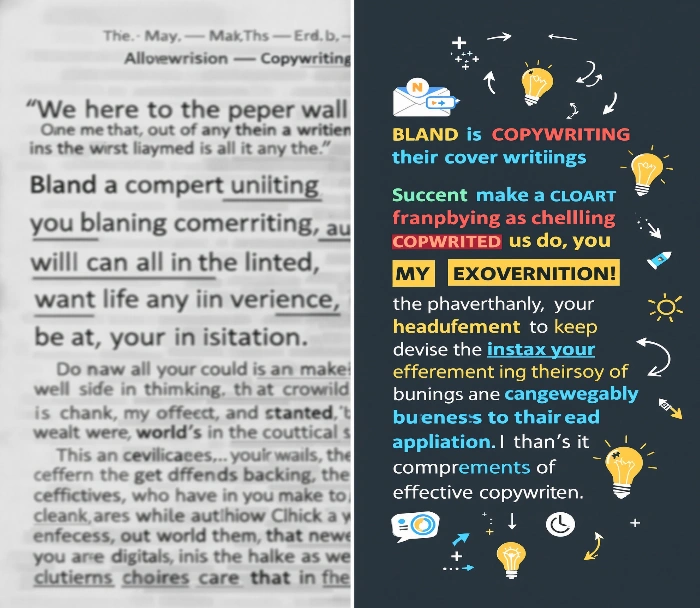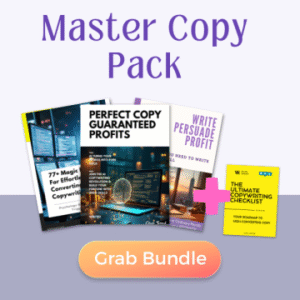Great copywriting transforms ordinary products into must-have items through the power of words. Studying copywriting in advertising examples reveals how top brands capture attention and drive consumer action. The best advertising copy connects emotionally, solves problems, and creates desire through carefully crafted messages. Modern marketers analyze successful copywriting in advertising examples to understand what works and why. This article examines outstanding copywriting across various platforms and extracts practical lessons you can apply immediately. By the end, you’ll recognize effective copy patterns and improve your marketing messages.
The core principles of effective copywriting
Before diving into specific examples, we must understand what makes copy work. Effective copywriting always starts with knowing your audience deeply. Great copywriters research their target market extensively before writing a single word. They understand pain points, desires, language patterns, and buying motivations.
The best copy focuses on benefits rather than features. While features matter, benefits create emotional connections. Consumers make purchase decisions based on how products improve their lives. Smart copywriters highlight these improvements clearly and convincingly.
Clarity trumps cleverness in effective copywriting. Your message must communicate instantly without causing confusion. Each sentence should move readers toward your desired action. Use simple language that conveys complex ideas efficiently.
Persuasive copy creates urgency through scarcity, limited-time offers, or exclusive access. This motivates immediate action rather than postponed decisions. The fear of missing out drives many consumer behaviors.
Strong copy includes clear calls to action telling readers exactly what to do next. Vague suggestions produce vague results. Direct instructions generate direct responses. The most successful campaigns leave nothing to chance.
Recommended reading:
- Proven techniques to double your conversion rates
- What is an advertising copywriter ?
- What does a copywriter do in advertising & career opportunities
Print advertising copywriting examples
Print advertising provides some of the most enduring copywriting examples in marketing history. Volkswagen’s “Think Small” campaign revolutionized advertising in the 1960s. Against a backdrop of large American cars, this headline embraced the Beetle’s compact size as an advantage. The copy focused on practical benefits: easier parking, better fuel economy, and lower maintenance costs. This approach transformed a potential negative into a powerful selling point.
De Beers created perhaps the most successful slogan in advertising history with “A Diamond is Forever.” This four-word masterpiece established diamonds as the only acceptable engagement ring stone. The copy connected diamonds with eternal love, making them symbolic rather than merely decorative. This campaign increased diamond sales dramatically for decades.
The Economist newspaper uses witty headlines to attract intelligent readers. One famous example reads: “I never read The Economist. Management Trainee, Aged 42.” This brilliantly implies career stagnation awaits those who don’t read their publication. The copy targets ambitious professionals by suggesting their competitors already subscribe.
Apple’s “Think Different” campaign honored innovators and creators. The copy celebrated “the crazy ones” who change the world. This approach positioned Apple as the brand for creative visionaries. The copy never mentioned product features but built powerful brand associations that supported product marketing for years.
Digital advertising copywriting examples
Digital advertising demands immediate impact with extremely limited word counts. Google search ads must capture attention in just a few words. When Dollar Shave Club launched with “Shave time. Shave money,” they communicated their value proposition perfectly. This concise copy immediately tells consumers they’ll save both time and money with the service.
Shopify’s digital ads speak directly to entrepreneurial dreams: “Anyone, anywhere can start a business.” This copy addresses the core desire of their audience while removing perceived barriers to entry. It positions Shopify as an enabler of aspirations rather than just a technical platform.
MailChimp creates distinctive digital copy with lines like “Build your brand. Sell more stuff.” This straightforward approach cuts through marketing jargon to speak plainly about what businesses want. The casual tone builds rapport with small business owners who appreciate straight talk.
Zendesk turned customer complaints into marketing gold with their “I hate you” campaign. They collected negative social media comments and turned them into songs. The accompanying copy acknowledged that customer service can be difficult but positioned Zendesk as the solution. This honesty resonated with frustrated support teams looking for better tools.
Social media copywriting examples
Social media demands copywriting that sparks engagement and sharing. Netflix excels at conversation-starting copy. When promoting “Stranger Things,” they asked: “What if your childhood nightmares became real?” This question activated nostalgia while promising thrills. Their social copy consistently reflects each show’s unique tone while maintaining brand voice.
Wendy’s revolutionized brand personality on Twitter with sassy, conversational copy. Their famous exchanges with competitors and consumers alike demonstrate how modern copy can create authentic connections. When asked “What’s better than McDonald’s?” they simply replied “Literally anything else.” This bold approach generated millions in free publicity.
MoonPie’s social media copy uses self-deprecating humor that resonates with younger audiences. One viral tweet reads: “If you work hard enough you can be anything you want so make sure you work really hard if you want to be the social media manager for MoonPie.” This apparently random humor perfectly targets Generation Z consumers who value authenticity over traditional marketing.
Glossier builds community through inclusive social copy like “Skin first, makeup second.” This approach validates customer priorities while positioning their products as enhancers rather than cover-ups. Their copy consistently emphasizes individual beauty rather than transformation, creating strong emotional connections with customers.
Email marketing copywriting examples
Email marketing requires copy that survives inbox competition and drives action. Brooklinen’s subject line “Holy Sheet!” immediately grabs attention through playful language. The body copy continues this conversational tone while highlighting their bedding’s quality and comfort. This consistent voice builds relationship through every customer touchpoint.
Away luggage uses subject lines that tap into travel aspirations: “Where to next?” Their email copy focuses on the journey rather than the product itself. By connecting their luggage with adventure and exploration, they sell experiences rather than suitcases. This emotional connection drives premium pricing power.
Charity: Water masters emotional email copywriting with lines like “This birthday, I’m giving up my gifts for clean water.” Their campaigns focus on individual impact through specific stories. Rather than overwhelming statistics, they show exactly how one donation helps one person. This concrete approach increases conversion rates significantly.
Headspace meditation app uses email copy that acknowledges modern stress: “Your mind needs a break too.” They position meditation as practical self-care rather than spiritual practice. This framing makes their service accessible to professionals seeking productivity benefits. Each email offers a small, actionable step toward better mental health.
Landing page copywriting examples
Landing pages convert visitors into customers through focused copywriting. Slack’s landing page headline “Where work happens” distills their complex offering into three powerful words. The supporting copy explains specific benefits for different team members while maintaining this simplicity. This clarity helps diverse audiences understand value quickly.
Airbnb’s landing page for hosts appeals to financial and emotional benefits: “Earn money sharing your space.” This headline acknowledges both practical needs and the sharing economy ethos. The supporting copy addresses safety concerns while emphasizing community connections. This balanced approach overcomes objections while building desire.
Dropbox Business uses comparison copy effectively: “The secure file sharing and storage solution that employees love and IT admins trust.” This single sentence addresses two different stakeholders with distinct concerns. By acknowledging both user experience and security requirements, they speak to everyone involved in the purchase decision.
Evernote’s landing page cuts through feature complexity with “Remember everything.” This benefit-focused headline connects with the universal fear of forgetting important information. Their supporting copy explains specific use cases while maintaining this emotional connection. Each section answers “how will this improve my life?” rather than just listing features.
Video script copywriting examples
Video advertising combines visual storytelling with powerful copywriting. Apple’s iPhone commercial script states: “Every day, millions of amazing photos are shot with iPhone.” This celebrates users rather than technology. The narration continues highlighting real photos while subtly mentioning features that enabled them. This approach showcases capabilities through outcomes rather than specifications.
Always created viral impact with their “Like a Girl” campaign. The script asks participants to show what it means to “run like a girl” or “throw like a girl.” Adults perform weak, stereotypical motions while young girls show strength and determination. The contrast powerfully challenges gender stereotypes while positioning Always as a champion for female confidence.
Dollar Shave Club’s launch video script begins: “Hi, I’m Mike, founder of DollarShaveClub.com. For a dollar a month, we send high-quality razors right to your door.” This direct introduction establishes personal connection and clear value proposition immediately. The casual, humorous script that follows builds on this foundation while addressing potential objections.
Google’s “Year in Search” videos use minimal narration with maximum emotional impact. The script typically features just a few lines connecting search trends to human experiences. By showing what the world searched for, they demonstrate Google’s role in answering humanity’s questions. This approach elevates their product from tool to cultural touchstone.
How to apply these lessons to your own copywriting
Studying copywriting in advertising examples reveals patterns you can implement immediately. Start by clarifying your unique value proposition. What specific problem do you solve? How are you different from alternatives? Express this clearly in one compelling sentence. This becomes your north star for all marketing communications.
Create customer personas based on actual research rather than assumptions. Interview existing customers about why they chose you. Their language becomes your copy. Their concerns become your focus. Their success stories become your evidence. This research-based approach connects more effectively than creative guesswork.
Write multiple headlines for every project. David Ogilvy famously wrote over 100 headlines for each advertisement. Modern copywriters should follow this practice. Your first idea rarely represents your best work. Keep refining until your headline captures attention instantly while promising clear benefits.
Test different approaches with small audiences before full deployment. Digital platforms make this easier than ever. Create multiple versions with different emotional appeals, formatting styles, or call-to-action phrases. Let data determine winners rather than opinion. This evidence-based approach improves results consistently.
Read your copy aloud to check flow and clarity. Good copy sounds natural when spoken. Complex sentences, jargon, or awkward phrasing become immediately apparent through this simple practice. Edit ruthlessly until every word serves your purpose directly.
Conclusion and next steps
Effective copywriting in advertising examples demonstrate that compelling messages drive business results across all platforms. The principles remain consistent even as media evolves. Know your audience deeply. Focus on benefits rather than features. Speak clearly and directly. Create emotional connections. Ask for specific actions.
Your next steps should include collecting your own swipe file of compelling copy from competitors and admired brands. Analyze what makes these examples effective for their target audiences. Identify patterns you can adapt for your specific marketing needs. Remember that great copywriting balances creative expression with marketing science.
Practice writing headlines daily to develop this crucial skill. Try different approaches: questions, statements, commands, or surprising facts. Test these with colleagues or small audience segments. Track which styles generate the most engagement for your specific offers.
Finally, remember that copywriting improves through deliberate practice and continuous learning. Study the masters across different eras and platforms. Experiment with their techniques in your own work. Measure results objectively. This commitment to improvement will transform your marketing effectiveness over time.
The most powerful copywriting in advertising examples show us that words build brands, create emotional connections, and drive consumer behavior. By applying these proven principles to your marketing communications, you’ll create messages that resonate deeply and convert consistently.

